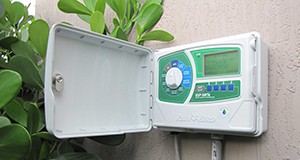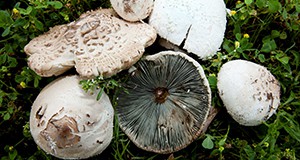
The “false parasol” or “green-spored parasol” mushroom (Chlorophyllum molybdites) is a poisonous mushroom that is the most common cause of mushroom poisoning in the United States. This mushroom is widely distributed throughout Florida and the southeastern United States. It commonly creates a complete or incomplete “fairy ring” in lawns, grassy areas, and open woods. When mature, the green-spored parasol mushroom has a large cap, a ring around its stem, and a greenish color on the underside of its gills. This four-page fact sheet describes the morphology, ecology, and distribution of the green-spored mushroom as well as its toxicology and how to treat poisoning from this mushroom. Written by Lisbeth Espinoza and Matthew E. Smith, and published by the Plant Pathology department.
http://edis.ifas.ufl.edu/pp324
Category: Lawn & Garden
Growing Plums in Florida
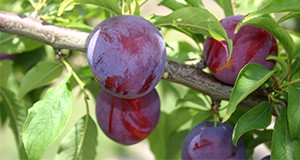
Plums could be a potential crop for growers and homeowners in Florida and other mild winter areas throughout the Gulf coast, but many plum varieties will not grow well enough in Florida to produce fruit. In response to this need, the University of Florida has developed cultivars that improve the potential for growing plums in Florida. This twelve-page fact sheet provides information for growing plums in Florida including information about chilling hours, pollination and fruit set, fruit harvesting, yields, as well as information about the plum cultivars adapted to grow in Florida. Written by M. Olmstead, E.P. Miller, P.C. Andersen, and J.G. Williamson, and published by the Horticultural Sciences Department.
http://edis.ifas.ufl.edu/hs250
Florida Gardening Calendars
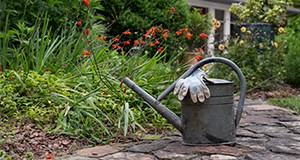
Not sure what to plant and when? Confused about how to care for your lawn differently during the winter or summer? Consult the Florida Gardening Calendar for your region (North, South, and Central). The calendars give instructions for planting ornamentals, fruits, and vegetables; lawn care and management; and irrigation and pest control for each month of the year. Split into sections about “What to Plant” and “What to Do,” these calendars are handy for any type of home garden. Written by Sydney Park Brown, and published by the Environmental Horticulture Department.
Central Florida Gardening Calendar: http://edis.ifas.ufl.edu/ep450
North Florida Gardening Calendar: http://edis.ifas.ufl.edu/ep451
South Florida Gardening Calendar: http://edis.ifas.ufl.edu/ep452
Native Aquatic and Wetland Plants: Duck Potato, Sagittaria lancifolia
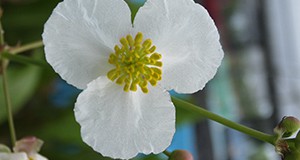 This 3-page fact sheet discusses the classification, description, habitat, propagation, and uses of duck potato, an aquatic perennial that typically grows in swampy ground or standing water in ponds, lakes, streams, and ditches and usually blooms in the spring. Written by Kimberly A. Moore, Luci E. Fisher, Carl J. Della Torre III, and Lyn A. Gettys, and published by the UF Department of Agronomy, December 2015.
This 3-page fact sheet discusses the classification, description, habitat, propagation, and uses of duck potato, an aquatic perennial that typically grows in swampy ground or standing water in ponds, lakes, streams, and ditches and usually blooms in the spring. Written by Kimberly A. Moore, Luci E. Fisher, Carl J. Della Torre III, and Lyn A. Gettys, and published by the UF Department of Agronomy, December 2015.
http://edis.ifas.ufl.edu/ag403
Native Aquatic and Wetland Plants: Cardinal Flower, Lobelia cardinalis
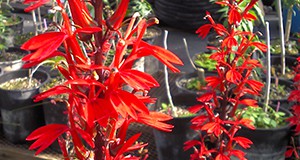 This 3-page fact sheet discusses the classification, description, habitat, propagation, and use of cardinal flower, an aquatic perennial that is commonly found in stream banks and swamps. Written by Kimberly A. Moore, Luci E. Fisher, Carl J. Della Torre III, and Lyn A. Gettys, and published by the UF Department of Agronomy, December 2015.
This 3-page fact sheet discusses the classification, description, habitat, propagation, and use of cardinal flower, an aquatic perennial that is commonly found in stream banks and swamps. Written by Kimberly A. Moore, Luci E. Fisher, Carl J. Della Torre III, and Lyn A. Gettys, and published by the UF Department of Agronomy, December 2015.
http://edis.ifas.ufl.edu/ag402
Native Aquatic and Wetland Plants: Blue-Eyed Grass, Sisyrinchium angustifolium
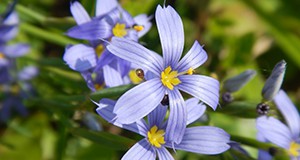 This 2-page fact sheet discusses the classification, description, habitat, propagation, and uses of blue-eyed grass, an aquatic perennial native to Florida. Written by Kimberly A. Moore, Luci E. Fisher, Carl J. Della Torre III, and Lyn A. Gettys, and published by the UF Department of Agronomy, December 2015.
This 2-page fact sheet discusses the classification, description, habitat, propagation, and uses of blue-eyed grass, an aquatic perennial native to Florida. Written by Kimberly A. Moore, Luci E. Fisher, Carl J. Della Torre III, and Lyn A. Gettys, and published by the UF Department of Agronomy, December 2015.
http://edis.ifas.ufl.edu/ag401
Do-It-Yourself Insect Pest Traps

Many types of traps can be used to monitor or control insect pests. Traps to capture insects vary greatly, depending on the target, location, and purpose. Traps may be inexpensive and disposable, or more complex. This 12-page fact sheet describes several traps for common pests in the home, garden, and landscape that can be made using common household materials or that are readily available in stores. Written by Steven Arthurs and Adrian Hunsberger and published by the Entomology and Nematology Department.
http://edis.ifas.ufl.edu/in1103
Landscape Design Software: Evaluation and Recommendations for Homeowners
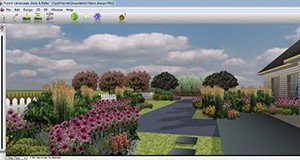
Homeowners who are computer literate and want to improve their landscapes often consider purchasing software so that they can create the design themselves and save money. To help you select a program from the dozens that are available, each with different levels of cost and difficulty, UF/IFAS scientists tested seven popular do-it-yourself programs, compared them to a professional landscape design software program, and rated them for quality of features and ease-of-use. This 9-page fact sheet written by Gail Hansen, Smith Watkins, and Sydney Park Brown and published by the Department of Environmental Horticulture will help you estimate costs, ensure compatibility with your Windows-based or Apple-based operating system, and compare reviews from consumer websites so that you can choose the software that best fits your needs.
edis.ifas.ufl.edu/ep526
Environmental Stresses and Your Florida Lawn
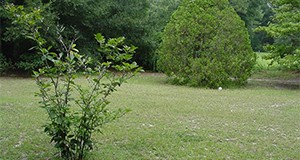
Florida lawns are subject to many environmental stresses. These can include nutrient deficiency, salinity, temperature extremes, over- or under-watering, soil problems, and prolonged exposure to shade or traffic. The use of proper cultural practices will help keep your lawn healthy and more stress-tolerant. This two-page fact sheet explains how to choose the most appropriate grass, fertilize properly, mow to the correct height, and irrigate for your lawn’s needs. Written by L.E. Trenholm, and published by the Environmental Horticulture Department.
http://edis.ifas.ufl.edu/ep070
Arrow Arum: Peltandra virginica
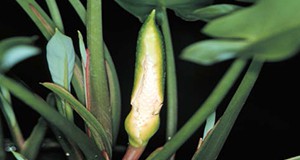 Arrow arum is a native aquatic and wetland plant that is a welcome addition to water gardens, aquatic ponds, and wetland restoration and mitigation sites. The species is broadly adapted and extremely common throughout Florida, and its perennial nature assures a stellar performance year after year. This new 3-page fact sheet provides an overview of this plant and discusses its distribution, habitat, propagation, and other uses. Written by Kimberly A. Moore, Luci E. Fisher, Carl J. Della Torre III, and Lyn A. Gettys, and published by the UF Department of Agronomy, October 2015.
Arrow arum is a native aquatic and wetland plant that is a welcome addition to water gardens, aquatic ponds, and wetland restoration and mitigation sites. The species is broadly adapted and extremely common throughout Florida, and its perennial nature assures a stellar performance year after year. This new 3-page fact sheet provides an overview of this plant and discusses its distribution, habitat, propagation, and other uses. Written by Kimberly A. Moore, Luci E. Fisher, Carl J. Della Torre III, and Lyn A. Gettys, and published by the UF Department of Agronomy, October 2015.
http://edis.ifas.ufl.edu/ag400
Sizzle and Passionista: Two New Lance-Leaved Caladium Cultivars
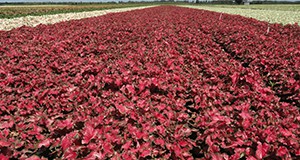 Many lance-leaved cultivars often produce small tubers, making it difficult for growers to produce tubers profitably. ‘Sizzle’ and ‘Passionista’ are two new lance-leaved caladium cultivars with improved tuber yield potential. The availability of ‘Sizzle’ and ‘Passionista’ may expand the color palette for caladium plants desired by greenhouse growers, nurseries, and gardeners. This 7-page fact sheet discusses the cultivars' tuber yield potential, container trials, landscape performance, growing recommendations, and availability. Written by Zhanao Deng, and published by the UF Department of Environmental Horticulture, December 2015.
Many lance-leaved cultivars often produce small tubers, making it difficult for growers to produce tubers profitably. ‘Sizzle’ and ‘Passionista’ are two new lance-leaved caladium cultivars with improved tuber yield potential. The availability of ‘Sizzle’ and ‘Passionista’ may expand the color palette for caladium plants desired by greenhouse growers, nurseries, and gardeners. This 7-page fact sheet discusses the cultivars' tuber yield potential, container trials, landscape performance, growing recommendations, and availability. Written by Zhanao Deng, and published by the UF Department of Environmental Horticulture, December 2015.
http://edis.ifas.ufl.edu/ep527
Long Squash: An Asian Vegetable Emerging in Florida
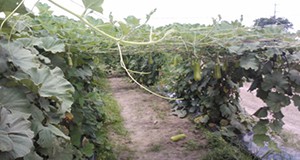 Long squash is an annual, vigorous, and herbaceous crop that was brought to the Americas by Paleoindian populations from Asia before the arrival of Columbus. This 4-page fact sheet provides an overview of this plant as well as recommendations for individuals in Florida who are interested in growing it. Written by Guodong Liu, Yuncong Li, David Dinkins, Bonnie Wells, Qingren Wang, and Yuqi Cui, and published by the UF Department of Horticultural Sciences, December 2015.
Long squash is an annual, vigorous, and herbaceous crop that was brought to the Americas by Paleoindian populations from Asia before the arrival of Columbus. This 4-page fact sheet provides an overview of this plant as well as recommendations for individuals in Florida who are interested in growing it. Written by Guodong Liu, Yuncong Li, David Dinkins, Bonnie Wells, Qingren Wang, and Yuqi Cui, and published by the UF Department of Horticultural Sciences, December 2015.
http://edis.ifas.ufl.edu/hs1272
Pest Identification Guide: An Introduction to Thrips
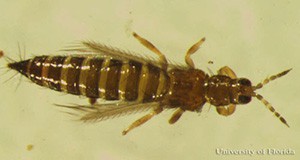 Tiny insects called thrips are difficult to see with the unaided eye but cause very obvious and sometimes ruinous damage to the flowers, buds, and fruit of many important crops. This two-page guide asks and answers the key thrips questions that allow growers to distinguish between chilli thrips, common blossom thrips, and Western flower thrips to more effectively battle against these destructive pests. What does it look like? What is its life cycle? Where is it found? What type of damage does it cause? And, most importantly, who are its natural enemies? Use this guide to help you identify thrips so that you can take effective steps to control them and limit the damage they cause. Written by Nicole Casuso and Hugh Smith with photos by Lyle Buss, Jeff Cluever, Vivek Kumar, P.M.J. Ramakers, Gary Vallad, and Hugh Smith. Published by the Entomology and Nematology Department, UF/IFAS Extension.
Tiny insects called thrips are difficult to see with the unaided eye but cause very obvious and sometimes ruinous damage to the flowers, buds, and fruit of many important crops. This two-page guide asks and answers the key thrips questions that allow growers to distinguish between chilli thrips, common blossom thrips, and Western flower thrips to more effectively battle against these destructive pests. What does it look like? What is its life cycle? Where is it found? What type of damage does it cause? And, most importantly, who are its natural enemies? Use this guide to help you identify thrips so that you can take effective steps to control them and limit the damage they cause. Written by Nicole Casuso and Hugh Smith with photos by Lyle Buss, Jeff Cluever, Vivek Kumar, P.M.J. Ramakers, Gary Vallad, and Hugh Smith. Published by the Entomology and Nematology Department, UF/IFAS Extension.
http://edis.ifas.ufl.edu/in1058
US Consumer Preferences for Home Lawn Fertilizers
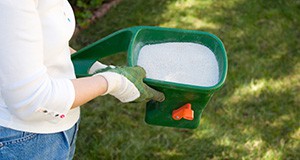
Consumer preferences for home lawn fertilizers are not always informed and do not always align with best practices. Understanding the disconnect will help turf industry educators better address consumers’ misperceptions about fertilizers, and help industry stakeholders design more appealing products and educate consumers effectively as they promote them. Knowing consumer preferences greatly reduces stakeholders’ risks and improves efficiency in determining future product and promotional strategies. This 4-page report discusses the findings of a 2013 survey of 1,066 US homeowners about their preferences and willingness-to-pay for various lawn fertilizer attributes. Written by Hayk Khachatryan, Alicia Rihn, and Michael Dukes and published by the Food and Resource Economics Department.
edis.ifas.ufl.edu/fe975
Florida Consumer Perception of the Fresh from Florida Campaign on Horticulture Plants
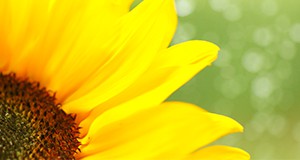
Consumer demand for local products is increasing all the time because of perceptions of superior quality and the idea that local products benefit personal health, the local community, and the environment. Many states have publicly funded marketing programs to promote the consumption of local products. In a new development in Florida, the Department of Agriculture and Consumer Services (FDACS) has partnered with the Florida Nursery, Growers, and Landscape Association to include horticulture plants in the state’s Fresh from Florida campaign for the first time. This 3-page report written by Hayk Khachatryan and Alicia Rihn and published by the Food and Resource Economics Department provides an overview of Florida consumer perceptions of the new Fresh from Florida campaign for horticultural plants. Growers, wholesalers, marketers, and retailers can use the tips inside to understand consumer perceptions and discover how best to use the promotional materials of the new program to reach consumers, reduce economic risks and improve their returns on investment.
http://edis.ifas.ufl.edu/fe976
Florida Vegetable Gardening Guide — Revised!
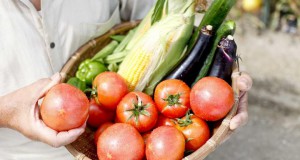
Vegetable gardening offers fresh air, sunshine, exercise, enjoyment, mental therapy, nutritious fresh vegetables, and economic savings, as well as many other benefits. With some attention to planning and planting, vegetables can be grown year-round in Florida. This 11-page guide provides recommendations primarily for traditional home gardens, including planning your garden and choosing crops, soil preparation and maintenance, fertilization, irrigation, pest management, and other gardening know-how. Includes a planting guide, table of suggested varieties, and table of products labeled for insect and mite management in home vegetable gardens. Written by Sydney Park Brown, Danielle Treadwell, J. M. Stephens, and Susan Webb, and published by the Environmental Horticulture Department.
http://edis.ifas.ufl.edu/vh021
The Social Organization of Honey Bees
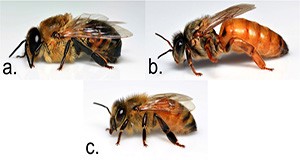
A honey bee colony is a superorganism, which means that together its members function like a single animal. Bees within a colony work together like the cells in a human body. They warm the colony in the winter by vibrating their wings to generate heat and cool it in the summer by ferrying in droplets of water and fanning air over them. Worker bees fan air into and out of the colony entrance in distinct inhalations and exhalations. Colonies reproduce by swarming to create new daughter colonies that in turn thermoregulate, breathe, and reproduce just as a single autonomous animal does. In three pages this fact sheet explains the intricate caste system and age-based division of labor that allows colonies of humankind’s best-loved pollinators to function and thrive. Written by Ashley N. Mortensen, Bryan Smith, and James D. Ellis and published by the Entomology and Nematology Department.
http://edis.ifas.ufl.edu/in1102
Encouraging Landscape Water Conservation Behaviors Series Overview #7: Personal and Social Norms of Florida Residents Who Use Irrigation in the Home Landscape
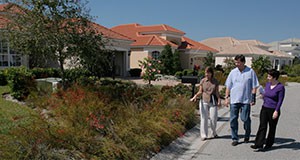
This 4-page fact sheet is the seventh publication in a series focusing on encouraging water conservation among Florida residents who use irrigation in their home landscapes. Extension educators create programs to encourage good irrigation practices and water conservation activities based on personal and social normative beliefs. To help in this goal, the authors examine personal and social norms of Florida residents who use irrigation in the home landscape and describe how Extension educators can capitalize on these positive norms to motivate Floridians to learn and use best water conservation practices. Written by Anil Kumar Chaudhary, Laura A. Warner, Alexa Lamm, Joy N. Rumble, and Randal Cantrell and published by the Agricultural Education and Communication Department.
http://edis.ifas.ufl.edu/wc205
Frequently Asked Questions about Soil Moisture Sensor Irrigation Controllers (SMS)
![]()
A soil moisture sensor (SMS) is a device that detects how much moisture is in the soil and prevents an irrigation system from running when it is not needed. This 4-page fact sheet written by Paul Monaghan, Ondine Wells, Michael Dukes, Maria Morera, and Laura Warner and published by the Department of Agricultural Education and Communications explains how the technology functions as well as how to install, program, operate, and maintain an SMS for a money- and water-wise sustainable home landscape that’s lush and beautiful.
http://edis.ifas.ufl.edu/wc238
Frequently Asked Questions about Evapotranspiration (ET) Irrigation Controllers
Evapotranspiration is the amount of water that is released into the atmosphere through evaporation and plant transpiration. An evapotranspiration irrigation controller is a device that uses data about the landscape, the type of irrigation system, and local weather conditions to determine when and how much to irrigate. This 5-page fact sheet written by Paul Monaghan, Ondine Wells, Michael Dukes, Maria Morera, and Laura Warner and published by the Department of Agricultural Education and Communications explains how the technology functions as well as how to install, program, operate, and maintain an ET controller for a money- and water-wise sustainable home landscape that’s lush and beautiful.
http://edis.ifas.ufl.edu/wc237
